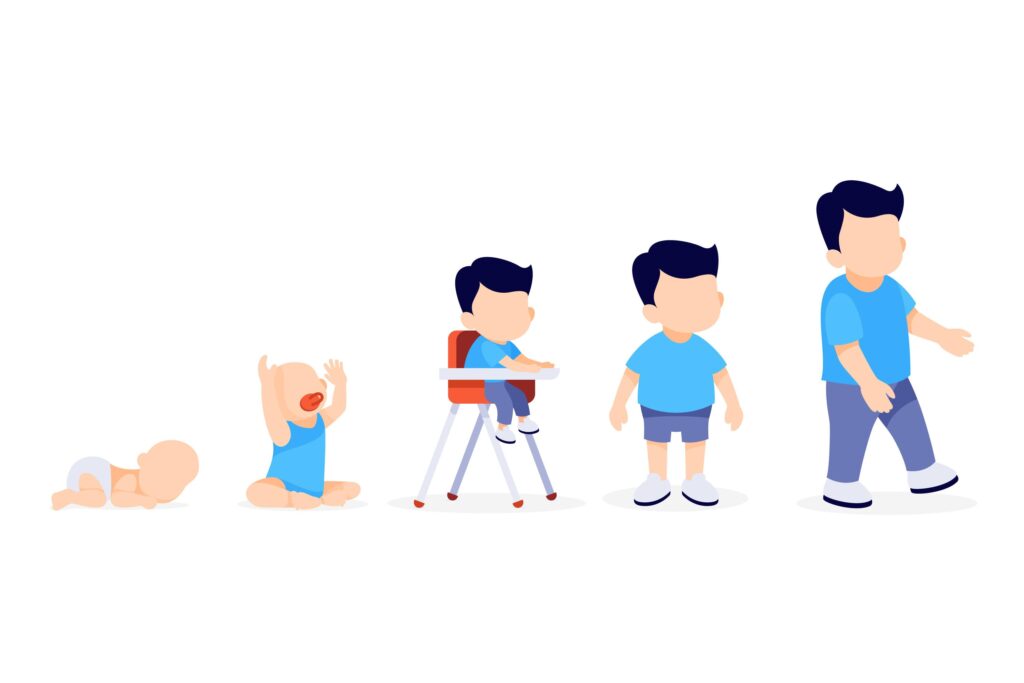Kids stop wearing diapers around 18 months to 30 months in general, though this is not universal. Depending on children’s behaviour you can stop using their nappies early or late.
At What Age Do Kids Stop Wearing Diapers?

Introductions
A major concern for many parents, is at what age do kids stop wearing diapers?
If your kid can walk alone, bring his toys from the basket, asking you questions- it’s your time to separate diapers from your baby. However, there is more to it.
In this article, I will tell you what age kids stop wearing nappies, what the signs are for their readiness, etc. Let’s get started.
What Age Do Kids Stop Wearing Diapers?
There is no age confirmation or telling regarding how old are babies when they stop wearing diapers. Many babies show behavioural signs that tell us, the parents, that we can stop having them wear nappies and start preparing for potty training.
According to Cindy L. E. Gellner, a certified physician in Pediatrics,
“The average age for starting to potty train is anywhere between 18 months and two and a half years.”
This is the age when a child stops wearing diapers, but this can vary from child to child.
How Long Does the Potty Traning Take?
It will take 2-4 weeks for your child to make the potty training a success. However, the process can vary based on boys and girls (as girl babies have a faster response), daytime and nighttime, interest your kids have in learning etc.
Signs of Readiness
You can expect your child to show different behaviours. They will demonstrate many signs, and you will feel the back of your mind. I have noted down some common symptoms children show before they are trained. Let’s check those out.
Good at Gross Motor Skills
If your child is good at balancing his hands, legs, and body and is flexible in sitting, walking, moving, and standing up on his/her own, you can start the training. Ensuring this will keep the baby safe when s/he is to do the job alone.
Exhibiting Physical Signs
Children show different physical signs whenever they need to go to the toilet. Some of the most common ones, for example, have sequential bowel movements, urinate a fair amount, work coordinately, etc. If these symptoms are found, you can prepare them for potty training.
Holding the Urge to Pee
You know it’s time for the baby to discharge, but s/he isn’t doing it. Or, they don’t need diaper change so often nowadays. Even s/he runs away when asking for to pee or poop. Sounds familiar? If your baby is holding their needs to the bathroom, that’s your call to prepare him/her for potty training.
Shows Discomfort When It’s Time
Children sometimes show discomforting behaviour when they feel the urge to pee or poop. For example, they
- May fidget
- Hold pants or diapers
- Stay hidden
- Go somewhere quiet
If you find any type of similar symptoms in their actions, you should start preparing them for potty training.
Shows Interest in Bathroom
Your little angel follows you everywhere, even in the bathroom. Doing so makes him/her interested, as s/he plays with toilet tissue, wants to flush, using toiletries to wash hands. You can take those behaviours as a sign of their readiness to proceed further.
Wakes up Dry
It’s common for babies to get wet at night. This changes only when they are trained. But what if your kid has not been trained, but even so, s/he is waking up dry from sleep? That’s a good enough hint to start their potty training.
Doesn’t Like Getting Wet
Though it’s kids’ nature, they love to play with water, but they don’t like staying stinky or dirty. For example, if they get cookie crumbs in their hand, they tend to wash them or ask you to clean them. The same goes for them peeing or pooping; they will ask you to clean them or to change their pant/diaper as they feel a certain discomfort in their body. Count this as a sign of their readiness and start training them.
Aware of the Cognitive Signs
If your baby is old enough to understand the instructions you give him/her or does the actions accordingly as you tell, understand their internal physical movements, and create their own words for pee or poop— this is one of the obvious signs that s/he is ready to be trained up. At times, many children may act up, but be patient. As long as you are willing, they will be learning.
External Behaviour Signs
If your child can try to pull down their pants, tell you about the bowel movements, or once they are done, tell you about it- you can see they are genuinely interested. So, without delay, start training.
Potty Training Techniques
So, you found your toddler is ready for the training. That’s good. There are several techniques you can follow to get the process started.
Technique 1: Deadline or Schedule Basis
You can set a certain deadline and follow a certain time for that. Let’s say, you will train her for 2-week for every morning. When she wakes up, let her use the bathroom instead. At the end of the training, the baby will know when s/he should use the toilet.
Technique 2: Three-Day Method
The idea is to let the baby wear other wearables but a diaper, intended for them to understand their body.
Let the baby wear pants. You can choose any funny-looking or cartoon-printed pants to encourage him/her to wear all day long. Be prepared for that to get dirty and messy, and it’s okay.
If everything goes okay, s/he will either be ready or have an idea of the bowel process and what s/he needs to do at the end of the training.
Technique 3: Reward Basis
If you are struggling to keep your child motivated to stick to the potty training, then you can add incentives. For example, candies, food, and stickers every time they finish the training session. This little boost-up will greatly please them and encourage them to continue the process.
Technique 4: Comfortable Location
There are many kids, and whenever they see people, their urge for the bathroom goes away. So, before letting them just use their potty chair, allow them some time to adjust, and ask them if they want to move anywhere. Location plays a vital role in making their habit.
How to Initiate
You know the techniques; now it’s time to implement them. How are you going to do that?
Equipment
Go to buy a potty chair while shopping with your kids. Let him/her choose his/her own potty chair. As children follow their parents, the father can teach the boys, and the mother can teach the girls how to use it. Whenever any diaper or pants get dirty, you can pick that up and put it on the potty chair. Visually show the baby how to use the equipment. They will follow by instinct.
Words That Work
I’ve seen many parents using the word related to potty. And that’s the cue, and the baby understands right away what needs to be done. So, the first step is to choose the words. Please use words in a positive way, not any slang or awkward words. Encourage him/her every little work s/he does. Be it he sat alone on the potty chair or went to clean up himself.
Notice Movement
Keep your child’s activities in check whenever s/he needs to use the toilet. Whenever they are squirming, facial expressions change, leaking belly gas, holding the genital area— act fast. Have them sit on their potty chair or in the bathroom. Introduce this idea in their head to regulate the habit. So, next time, whenever they feel this way, they know where to go.
Hygiene
Potty training is the right time to start personal hygiene training for children, two birds in one stone. When to wash their hands, how to wash themselves after they have used the toilets, and what happens after they wash; explain these to them. Talking to them makes the task easy for them to understand.
Nighttime Diaper Transition
Wait a minute. Potty training during the daytime is pretty manageable. But what about the night? At what age should my child stop wearing nappies to bed?
Do not worry; I have solutions for that. For starters, get your child used to the bedtime routine.
Let’s say the kids need to go to bed by 10 pm; you can get them to use the toilet just before that. Do that for a couple of days, and they will get a grasp of it.
If you need to change their diaper anytime later at night after they have fallen asleep, do that as silently and stealthy as possible, as it’s difficult to put them back to sleep once they wake up.
Also, while choosing diapers, pick high-quality ones. Those are generally soft and absorbent and do not cause diaper rash; thus, they are safe to use.
Once the child starts adjusting to the daytime potty training, s/he will naturally stop wearing diapers at night.
Overcoming Challenges
Doing everything during the day and keeping an eye on the baby at night, with tiredness of the whole world. It’s difficult. I understand how you feel.
But please be patient and calm with this. Their childhood will soon pass, and they will grow up very soon. And you will miss these moments, believe me!
Let me assist you. Here are some common challenges you will face and how you can SOLVE THEM WITHIN THE SHORTEST POSSIBLE WAYS.
Challenge 1: Preparation for the Nighttime Routine
It’s challenging to deal with babies’ nighttime routines, and any unpredictable incident can happen. Be prepared for any accident.
- Train the baby so that s/he can go to the toilet on his/her own.
- Use a waterproof mattress protector for the baby.
- Keep his/her toilet chair near the vicinity of the eyes.
Challenge 2: Baby Gets Awake at Night
Your baby might wake up while you are changing his diaper due to light, movement or sound. Try not to excite him/her. I know some moms who avoid eye contact and don’t talk even if the baby talks. If they see you are not reactive, they tend to go back to sleep.
Challenge 3: Babies are Getting Wet Frequently
It’s normal, and this is why using high-quality diapers is important. Also, practice helps them get used to toilet training; however, getting fully accustomed to the habit will take years. Don’t be forceful; even if it takes time, it’s worth it.
Challenge 4: Your Kid is Scared
Children are easily scared of the dark; if going to the bathroom at night scares them, you can keep the light on there. You can also tell them it’s okay to wake you up at night if they need to go to the bathroom.
Frequently Asked Questions (FAQs)
Question: Is it normal for a 4-year-old to wear diapers?
Answer: Yes, it is normal for a 4-year-old baby to wear diapers, especially the boys. You don’t have to be worried about this. However, you can still work on your kids to grow interest in potty training, one step at a time.
Question: At what age should a child be fully potty trained?
Answer: Normally, a child is supposed to be properly potty trained between 3 and 4 years of age. It varies as children who have delayed responses will take time.
Question: What is the biggest sign your child is ready for potty training?
Answer: Children’s interests are the most common and biggest sign that they are ready. But sometimes, you can create interest or make them aware by habituating them in using.
Question: What are the main physical signs of readiness for potty training?
Answer: Some of the common physical signs are children restraining themselves, staying dry for a longer time, asking you to change their diaper, hiding whenever they need to use the toilet, etc.
Question: What is a diaper rule?
Answer: A diaper rule indicates the schedule of a baby’s diaper changing. Generally, babies need their nappies changed every 1-3 hours.
Question: When do babies stop wearing newborn diapers?
Answer: Babies changing from newborn diapers to regular ones vary depending on gender. Typically, boy babies stop wearing newborn diapers at 1 month of age. Girl babies will stop wearing newborn diapers at around 2 months of age.
Conclusion
I hope this article helps you understand children’s behaviour and when and how to prepare for potty training.
Every child is different, and there is no universal rule for this.
Most children are prepared even before their age, whereas some children never show any signs.
Whether they show any signs or not, trust your gut feeling.
If you feel your child needs to be educated in this, then you can encourage him/her.
And as long as you are patient, you will see the results.






